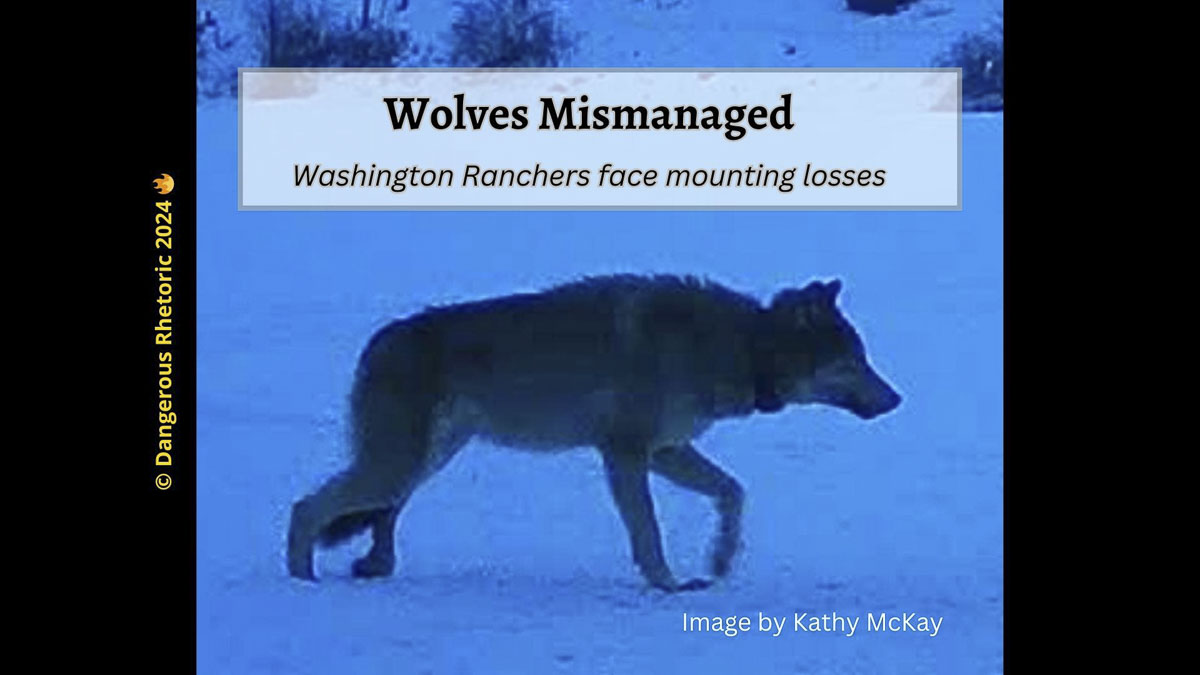
Nancy Churchill discusses the mounting losses suffered by Washington ranchers
Nancy Churchill
Dangerous Rhetoric
The debate over wolf conservation and livestock protection shouldn’t be framed as an either-or issue. Rural residents who work the land are usually staunch conservationists. Their livelihoods depend on a deep understanding of the environment and maintaining nature’s delicate balance.

Washington can — and should — support both wolves and livestock through proper balance. However, the Washington Department of Fish and Wildlife is falling short. Bureaucrats, activists, and lawmakers must prioritize input from those directly affected — farmers, ranchers and hunters — and account for real-life losses to ungulate herds and livestock. This requires relying on accurate wolf population data and permitting more effective deterrence measures for managing problem wolf packs.
Wolves return with the snow
Kathy McKay, the owner of K-Diamond-K Guest Ranch in Republic, faces significant challenges due to wolf predation on her livestock. Non-lethal deterrence measures often require livestock producers or range riders to brave snow, sub-zero temperatures and rugged terrain in the middle of the night to attempt to “scare” the dangerous and clever apex predators. In addition to range riders, other non-lethal measures include fladry and guard dogs. Unfortunately, wolves don’t scare easily when their stomachs are empty, the snow is deep, and ungulate herds are already thinned out by too many wolves concentrated in a small area.
In a recent facebook post, McKay noted her most recent livestock losses: “two sleepless nights in a row, one dead Scottish Highlander and a missing calf. Wolves have returned, haunting us and always hungry. Game cameras leading into the ranch from every trail and this is what I wake to at 2:30 a.m. both nights. It’s dark, snowing and just plain dangerous to be out in this weather. If the wolves don’t kill me it will be the elements associated with them.”
Sleepless nights and the ongoing loss of livestock will be a fact of life for the rest of the winter and into the late spring for McKay and other eastern Washington cattlemen. A producer must lose multiple animals to proven wolf predation before WDFW will consider action to cull members of a problem pack.
Fladry is a non-lethal method used to deter wolves and other predators from entering specific areas, such as pastures or livestock grazing zones. It consists of a line of rope or wire with strips of brightly colored flags or fabric attached at regular intervals. The fladry line is strung around the perimeter of the area to be protected.
In theory, the fluttering flags and unfamiliar motion create a psychological barrier for wolves, which are naturally cautious animals. However, wolves are very smart, and can become habituated to fladry over time. Fladry is laborious to set up and requires regular upkeep to ensure it remains functional and intact. It is most effective in protecting smaller areas, as maintaining it over large grazing lands is challenging. It’s simply not affordable or effective when the stock is scattered over thousands of acres.
Background on wolf recovery
Unfortunately, a significant concentration of wolf packs reside in northeastern Washington. Dangerous Rhetoric documented this in “The Successful Recovery of Washington Wolves.”
Gray wolves, once eradicated from Washington by the 1930s, have made a notable comeback since 2008. At the end of 2022, WDFW reported a minimum of 216 wolves in 37 packs, with at least 26 successful breeding pairs.
The gray wolves play an important role in ecological balance. As apex predators, wolves help regulate prey populations, which in turn supports the health of various plant and animal communities. Their presence contributes to the overall stability and diversity of Washington’s ecosystems.
In a Feb. 1, 2023 work session for the House Agriculture and Natural Resources Committee, WDFW presented a map illustrating 22 of the state’s 33 wolf packs were located in this region. “If you look at the density of wolves in northeast Washington compared to the rest of the state, you can see we have enough wolves in just a few counties to meet the statewide delisting criteria,” said Rep. Joel Kretz, R-Wauconda.
Losses mounting for producers
An article on Capital Press titled “Washington ranchers: Process too hazy for clear decisions on wolf removal,” documented the complaints of ranchers who attended a recent meeting of the WDFW Wolf Advisory Group held in Colville Nov. 19.
At the meeting, Asotin County rancher Samee Charriere said “she lost 17% of her calves this year to wolves. Fish and Wildlife stated ranchers in her area had not done enough to prevent the attacks to warrant lethal control, without elaborating on the shortcomings. ‘I want all of you to take 17% of your wages and burn them,’ Charriere said. ‘That’s the effect I’m feeling.’”
The lack of good communication between WDFW and the ranchers highlights the need for balanced solutions that consider the realities faced by ranchers like McKay, Charriere and others.
“[Scott] Neilson, who organizes the Cattle Producers of Washington range-riding program, said greater weight should be given to the department employee who works with ranchers to prevent conflicts and sees the carnage. ‘Our relationship with our conflict specialists is extremely important,’ he said. ‘That relationship between the producer and the conflict specialist needs to rule the day.’”
Washington residents who support better wolf management and fair compensation for livestock producers should follow the Wolf Advisory Group. Plan to attend future meetings and submit public comments at those meetings. Questions and respectful comments could also be submitted to the contact provided for the group, Subhadeep (Shubh) Bhattacharjee, Wolf and grizzly bear policy lead, at Subhadeep.Bhattacharjee@dfw.wa.gov.
Nancy Churchill is a writer and educator in rural eastern Washington State, and the state committeewoman for the Ferry County Republican Party. She may be reached at DangerousRhetoric@pm.me. The opinions expressed in Dangerous Rhetoric are her own. Dangerous Rhetoric is available on thinkspot, Rumble and Substack.
Also read:
- Letter: ‘I am a law-abiding citizen, who believes in the free speech of others’Jim McConnell of Vancouver shares his frustration over repeated sign thefts opposing changes to McGillivray Boulevard and defends the right to free speech in Cascade Park.
- Opinion: Taxes and assessed valuesDick Rylander explains how property tax proposals are calculated and urges Clark County residents to understand assessed values before voting on new taxes.
- Opinion: Why has Vancouver hired a shelter provider with a record of failure?Amy Harris questions Vancouver’s decision to hire Do Good Multnomah, citing documented failures and urging city officials to explain their choice.
- Opinion: Predators, politics, and public recordsNancy Churchill criticizes four Fish and Wildlife commissioners for secrecy and anti-hunting bias, calling for their removal and reform of the appointment process.
- Opinion: TriMet Better Red cost allocation revealedJohn Ley examines TriMet’s $204 million Better Red project, showing most of the spending wasn’t on vehicles or tracks—raising questions about cost transparency and regional funding.










